David B. Levy's Blog
March 31, 2012
Gone Fishin'
Published on March 31, 2012 15:10
March 25, 2012
Animondays Interview: Craig Bartlett
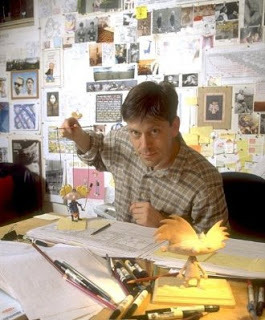
 When I worked at Nickelodeon, Blue's Clues brought in a regular series of guest speakers to give talks in hopes of inspiring our crew. Among the great people that passed through were George Griffin, J. J. Sedelmaier, Emily Hubley, and, one day, it was Hey Arnold! creator Craig Bartlett. His series was smart, funny, warped (think bully Helga's relationship with Arnold, whom she secretly worships), and ethical at the same time.
When I worked at Nickelodeon, Blue's Clues brought in a regular series of guest speakers to give talks in hopes of inspiring our crew. Among the great people that passed through were George Griffin, J. J. Sedelmaier, Emily Hubley, and, one day, it was Hey Arnold! creator Craig Bartlett. His series was smart, funny, warped (think bully Helga's relationship with Arnold, whom she secretly worships), and ethical at the same time. Near the tail end of Hey Arnold!'s five year production in 2000, execs started to look for edgier and more off-beat comedy series, in a trend that continues to this day with CN's Adventure Time and Regular Show. To the industry powers that be, the slightly gentler and calmer Hey Arnold!, as well as Jim Jinkins' Doug, felt as if they belonged to a different era. With such attitudes, it's not surprising that Bartlett and Jinkins would find their next success making shows for ages 2-5.
Bartlett's first series culminated with Hey Arnold!: The Movie in 2002 and after that he created several excellent pilots that failed to score series pickups. I remember visiting with him in L.A. at Cartoon Network in 2004 and, although he was his usual affable self, his frustration over his stalled pilots was obvious.
By 2009, his absence from TV ended with the debut of Dinosaur Train, a hit new series for PBS Kids.
On June 24, 2005, Bartlett sat down for interview for use in my book Your Career in Animation, which I'm happy to share below in its entirety for the first time. Some time I'll have to do a follow up with him to get more specific, but the purpose of this interview was on general career topics. Enjoy!
1-Where did the inspiration for your show ideas come from?
I always tap into my own experiences as a kid. And magnify them hugely, of course.
2-What was the biggest challenge, production-wise, in setting up your series?
Getting through the first season, before everyone has seen it and you can finally just run episodes to show them what you were talking about. The first season is where your idea can be "noted" to death.
3-How did you find your creative team?
The core team was made of friends that I had worked with on other projects. I'd worked in animation for more than 10 years before I got my own show, and I think it helped.
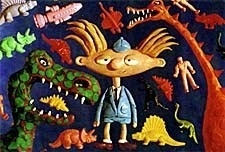
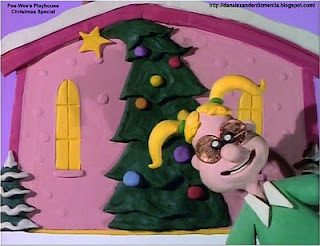 *Above two stills show the prototype for Hey Arnold, which debuted as a short for Sesame Street, and a still from a "Penny" cartoon made for Pee Wee's Playhouse, both of which experimented with an innovative 2D and 1/2 stop-motion clay technique.
*Above two stills show the prototype for Hey Arnold, which debuted as a short for Sesame Street, and a still from a "Penny" cartoon made for Pee Wee's Playhouse, both of which experimented with an innovative 2D and 1/2 stop-motion clay technique. 4-How much time do you (or did you) devote to your show
each week?
Probably 50 hours on average.
5-Can you describe how your show was pitched? And how many times over what period of time?
"Hey Arnold!" was pitched in August '93 to Mary Harrington in Burbank when she was head of Original Animation for Nickelodeon, kind of by accident, after myself and 5 other "Rugrats" writers had pitched several ideas we had come up with together. We talked for an hour or so and were out of ideas, so we pulled comics and other things out of our briefcases, just trying to find out what Mary liked. I showed her my videotape reel of old "Penny" cartoons that I had done for "Pee Wee's Playhouse" -- at the front of the reel were 3 Arnold cartoons that I had made myself, in the claymation "Penny" style. That got Mary's attention. I then showed her some Arnold comics that I had drawn for "Simpsons Illustrated," and it seems that one particular panel of Arnold screaming was the real clincher for her. She laughed and laughed. When the meeting adjourned, Mary buttonholed me outside and said that she wanted to pursue Arnold further. We six "Rugrats" writers then adjourned to a pizza place and debriefed about the meeting. The other five guys sensed that I had somehow gotten my own show out of the group meeting. Paul Germain said, "Arnold is gonna go to series, mark my words." I met with Mary over the next four months, refining a pilot outline, and the pilot was greenlit in January. The pilot was made in '94 and the series was greenlit a year later.
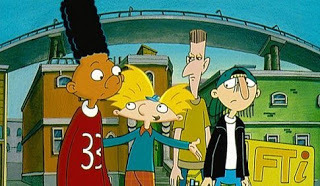
6-What is your opinion on the way network’s buy or develop shows? What would you change about that if you could?
I have been in development for years since I went to Cartoon Network at the end of 2001. I've pitched to them, to Nick, to Disney. I've met most of the development people in that world. No development person is obligated to tell you when your idea is dead with them, in other words to put it out of its misery and allow you to move on. They just don't return your calls and emails and let you guess.
7- Do show creators get stereotyped as comedy or action or preschool or adult etc? If so, what can be done about it?
As the creator of "Hey Arnold!" I am considered "soft." It's really annoying. I tried to break away from that by pitching a show to Spike called "Hellville," a show that takes place in Heaven and Hell -- Heaven is like a weird cult, and Hell is pretty much sex, drugs, and rock and roll. Spike passed on the show, but I send that script out so people won't stereotype me.
8-What role has attending animation festivals/events played in your career?
I go to the local events in L.A., but have only been to a couple international ones: Hiroshioma and Annecy. Haven't won anything at a festival. The international animation community is great.
9-What methods of self-promotion have you employed to get your name out there?
Hardly any. I keep thinking that my resume should speak for itself...
10-Are you a member of any animation/art or entertainment guilds or organizations? If so, what role has that played in your career?
I'm in the Academy of Motion Picture Arts and Sciences. I go to the screenings a lot, because their Goldwyn Theater in Beverly Hills is the best place to watch a movie anywhere. The audience is appreciative, they stay through the credits... it's where grownups watch movies. I guess it's also for networking, but I'm pretty low-key about it. I just love the movies, and I like to be on the nominating committee for animated features. You get to see the whole field of features that come out every year.
I've been in SAG since the start of "Hey Arnold!" which provides my health benefits, and I just joined the Writers Guild a week ago because I'm writing a live-action movie for Nick/Paramount. We'll see what that involves.
11-How do you stay on top of industry news and trends?
I like to read Variety -- excellent reviews of film, TV, and Legit. They have great columnists like Brian Lowry and editor Peter Bart.
12-What books should be in every animation library?
I love Leonard Maltin's history "Of Mice and Magic." And Preston Blair's cheap paperback books for drawing tips.
13-Have you gotten to meet or work with any of your animation heroes? If so, whom, and in what capacity?
Matt Groening is my brother in law. I enjoy walking through the ComicCon with Matt, because that's a world where every single person knows who he is. The guys who started drawing the Simpsons, David Silverman, Wes Archer, and Brad Bird were just a bunch of guys at Klasky Csupo once upon a time, when we were starting "Rugrats," and now they are big shots. Brad's career has been amazing. If you go to festivals, you can meet the international animators like Plympton, Newland, Preistley, Dreissen. These indies are always very nice people.
14-How different was the original vision for yourshow from what made it to the screen?
"Hey Arnold!" morphed hugely from claymation short to indie pilot to series, and even continued to evolve as the years went by and we found new ways to draw it. Some people felt that its original "spaghetti arms" look of the first season was better than where it ended up. Oh well. We did our best.
15- Is there any specific legal advice you’d pass along to future creators?
Get a good lawyer and read your deal. Try to get some kind of ownership/profit participation -- if they won't give it, find someplace else that will.
16-What are the typical daily duties of a creator/show runner on a TV series or feature production?
Each show is different. I concentrated on the story aspect, was most involved at the beginning and the end/post production parts of each cartoon. I love making the cut, being responsible for getting each show to length. And the mix is always fun, I never miss it.
17- Over time, has the amount of creative work you delegate to others grown? If so, how has that reshaped the show?
I stayed in it as much as I could. Delegating most of the art means that if your artists change, so will your show. But it's impossible not to delegate. It would make you crazy to do all of it.
18- How important, if it all, have self-initiated independent films or projects been to your career?
My Arnold shorts got it all started. I think everyone who wants to create a cartoon should try to make their own short to get the ball rolling. Your own short reveals your sense of art, story, timing, humor, tone. It tells much more than just pitching your idea ever could. Make a short!
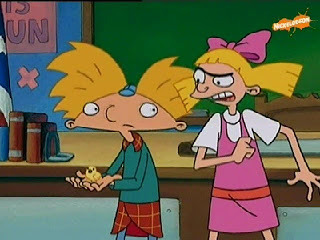
Published on March 25, 2012 06:21
March 16, 2012
BOW TIE: Yah! Yah! Yah!
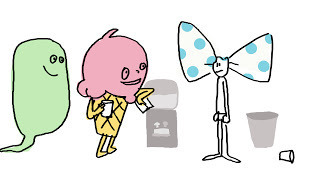 I am so late to the party.
I am so late to the party. As an adolescent I drew hundreds of short comic books with original characters and stories, sharing them with a close circle of friends. Handing my comic to a friend was my release date. It was me and my audience with nothing in between.
So when YouTube launched in 2005, did I snap up the new opportunity to make and distribute my own short cartoons a-la the comic books of my youth?
Nope.
It took me until 2012.
But, better late than never.
The catalyst to create and share my own cartoons was my recent pitch trip to L.A. where I once again experienced the deflating feeling of sitting through the average network pitch where execs poke, prod, and judge your creation. Sometimes they liked it, sometimes they didn't. And, no matter how professional and pleasant the meetings go, the results are nearly always the same: no dice.
But instead of hitting the hotel bar, I used my evenings to record new cartoon soundtracks into my iPhone. When I got home I was ready to try out some new ideas and experiment with a blend of characters, stories, and comedy. A month later I had 4 minutes of original cartoons. And, to further connect it to my childhood comic books, I used a character that dates back to when I was 13 years old: BOW TIE.
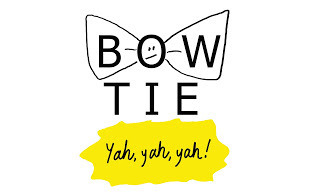 This has been an opportunity to explore odd little moments of everyday life by turning autobiographical events into fodder for short (and hopefully funny) cartoons. Ordinary life can be a wonderful source of inspiration. Emily Hubley has based several films on entries in her personal journals, such as her memorable film "One Self: Fish/Girl." Don Hertzfeldt packs a lot of autobiographical material into his groundbreaking trilogy of films. Yuri Norstein included a recurring fight with his mother in law over an umbrella in the lovely "The Heron and the Crane." Signe Baumane mined some private material in her brilliant and funny Teat Beat of Sex series.
This has been an opportunity to explore odd little moments of everyday life by turning autobiographical events into fodder for short (and hopefully funny) cartoons. Ordinary life can be a wonderful source of inspiration. Emily Hubley has based several films on entries in her personal journals, such as her memorable film "One Self: Fish/Girl." Don Hertzfeldt packs a lot of autobiographical material into his groundbreaking trilogy of films. Yuri Norstein included a recurring fight with his mother in law over an umbrella in the lovely "The Heron and the Crane." Signe Baumane mined some private material in her brilliant and funny Teat Beat of Sex series.When you start with something personal you might be surprised what bubbles up...
Sometimes the result is bittersweet.
Sometimes mundane.
Sometimes plain odd.
Sometimes weird.
Sometimes painful.
But most often with an "I- know-that-feeling" quality.
So far the most popular cartoon of the bunch has even been passed around as a "birthday greeting."
Best of all, since these are stories from life, it's impossible to run out of material.
BOW TIE episodes start as a list of anecdotes that I use as talking points to create a spontaneous script. I do all the voices myself (another new experience for me!), recording in story order from beginning to end. Most sound effects are verbal too, and occasionally supplemented by foley pulled in my apartment.
Next I lock the audio in After Effects, making a radio play of sorts. When it feels right I start animation. After a couple of hours I'm finished and importing the layers into AE for testing.
A critical next step is showing the test to my wife, Debbie, who has a great eye and sense of humor. Often she'll have a key note or set of suggestions that always improve upon the original.
Then (in no time flat) it's uploaded to the Aphids J. Kaboodle channel on YouTube. Every Wednesday morning I release a new cartoon by posting it on Facebook. And enthusiastic feedback has poured in from friends and industry folks alike, I even set up a Zazzle store with t-shirts featuring BOW TIE and friends.
Development execs and networks like to define and lock down creations. That BOW TIE drives a car in one episode and is driven around by his friend's mom in another, acts like a kid in one and has a job in the next wouldn't make sense to them. But it makes perfect sense to me. Most importantly, it's the perfect outlet for almost instant self-expression in animation.
I can't tell you how gratifying it has been to see friends and colleagues spreading the word by sharing the cartoon links through Twitter, Facebook, and e-mail. BOW TIE was even part of the shorts screening at the on-going comedy film festival The Iron Mule at the TriBeCa 92nd Street Y, where Aphids won the audience award!
So who is Aphids J. Kaboodle? You might be sick of David B. Levy and David B. Levy might be sick of you, but Aphids is brand new and can't wait to start alienating people!
I hope you take a minute or two to visit the Aphids J. Kaboodle Channel on YouTube, and maybe subscribe. And, if you're moved to share a cartoon or two with your friends, Mr. Kaboodle is in your debt...
Have fun! And, remember that it's okay to be late to the party, so long as you eventually arrive and bring a six pack of cider.
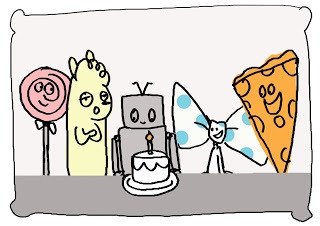
Published on March 16, 2012 08:52
March 11, 2012
Pushing for POE
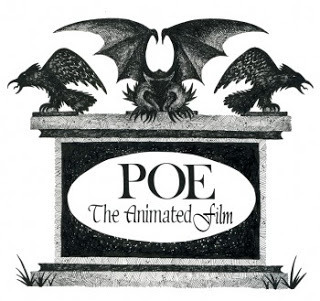 Sometimes a single opportunity can allow us to support a worthy project, a friend, and help promote an art form itself. On March 6th Oscar-nominated filmmaker Michael Sporn announced his first-ever Kickstarter campaign to help raise funds to complete a few minutes of final animation for his animated feature film POE. It’s my pleasure to use this week’s Animondays post to help his cause.
Sometimes a single opportunity can allow us to support a worthy project, a friend, and help promote an art form itself. On March 6th Oscar-nominated filmmaker Michael Sporn announced his first-ever Kickstarter campaign to help raise funds to complete a few minutes of final animation for his animated feature film POE. It’s my pleasure to use this week’s Animondays post to help his cause. First, on the project of POE, everyone who works in animation or enjoys the medium as a fan has something to gain by supporting this film. Today, animation is flourishing in mainstream feature films for children and families, through special effects in big action blockbusters, through innovative video games, in prime time and late night programing for “adults,” in preschool and children’s TV entertainment, as well as through the new media platforms of eBooks and apps. But, the one area that has the most untapped potential is in the intelligent and artful indie animated feature. POE is the rare project where subject, medium, and filmmaker (including collaborators such as the brilliant animator Tissa David), may all line up to help create something that can’t be found anywhere else.
Michael happens to be a friend of mine, but even if you don’t know him, he’s probably already helped you become a more thoughtful animator through his insightful and inspirational Splog posts since 2005, and maybe also stretched your perception of what the animated film can be. On the latter, his studio has led by example since 1980, making some of the most artful, daring, and affecting animated films of all time (go to the screenings button on this link to see this month’s TV schedule peppered with opportunities to see some of his films). A few of my all-time favorites include “Dr. Desoto,” "Abel's Island," “Morris’s Disappearing Bag,” “The Man Who Walked Between The Towers,” “Mona Mon Amour,” “Champagne,” “Ira Sleeps Over,” “The Marzipan Pig,” and “The Hunting of the Snark.”
As the owner/operator of one of the longest standing independent studios in the history of US animation, and through his formative years being trained in the art and craft of animation by the likes of John Hubley, Tissa David, and Richard Williams, Michael is a key creative link between animation’s golden age and today.
Michael has said that with POE he’d like to “give animation a grown up push.”
As grown ups who both love and work in animation, let’s help the man push.
Published on March 11, 2012 12:07
March 3, 2012
A Secret World of Quiet Dignity
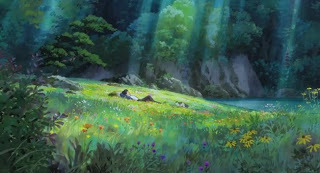
I didn’t plan on writing about The Secret World of Arrietty, the new feature film from Japan’s Studio Ghibli, and directed by Hiromasa Yonebayashi. But, after seeing the movie this week, there was no way I couldn’t write about it.
First some criticism (spoiler alert), because I had some issues with the film. The mother felt pretty one dimensional and old fashioned in the “hysterical female” stereotype, not to mention the oddness that she looked more like Arrietty’s grandmother than her mother. Also it was hard for me to believe that such a feisty and independent heroine could be raised by such a fearful mother. In contrast, the dad was all quiet stoicism. He was the calm to the mother’s storm. But, knowing how Miyazaki (who co-wrote the screenplay) is an expert in coloring characters with shades of gray, I wondered why he gave us such one-dimensional parental units.
My second, and only other issue in the film, is that when Arrietty is tested to do big things to save her mother’s life, her father is inexplicably absent. Maybe I missed something, but it seemed to me that there was no explanation on where the father was when the borrowers' home was invaded and the mother was abducted. Earlier we see the father had an injured leg but there’s no way that would have stopped him from protecting his family. I wonder if something was lost in the English translation.
But, these issues aside I really enjoyed the film. It would be easy to frame any discussion about this work in the 2D versus 3D context, but the qualities I love about Arrietty have little to do with that. In fact, the models of the characters in this film are so rigidly (and stiffly) followed in the animation that they may as well be unchanging 3D character rigs.
For me, the magic of this film is how it conveys big feelings and emotional moments through a low-key approach. I've been trying to explore a similar approach in my recent short films.
There’s a moment in Arrietty that took my breath away. Hollywood features try to do that with a big chase sequence, but in Arrietty the moment comes with absolute silence and a series of long confident shots. Arrietty is on her first mission as a borrower, being trained in the trade of survival by her father. Tissue was on her mother’s shopping list so the young girl and her dad scale a table to reach an ordinary tissue box. The two take their positions to grab at the tissue from either side but, in mid motion Arrietty notices (to her astonishment) that she’s being watched by a 12-year old human being, the sickly boy Shawn who is staying in his Aunt’s house to rest up before a heart operation. Shawn watches her with a sleep-awake stare and talks to her softly as if speaking from a dream. The whole moment freezes time and burned into my memory, replaying long after the film was over.
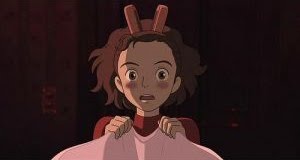 Arrietty frozen in fear mixed with curiosity in the moment described above.
Arrietty frozen in fear mixed with curiosity in the moment described above.And, there’s other things I appreciate just because, however slight and unimportant, they add to the experience:
-Shawn’s Aunt pulls up to their driveway and sees an exterminator’s truck parked in front of her. As her car pulls in and she gets out of the vehicle you can feel the smallness of the driveway, the tightness of the space. It’s a nice thing to have things like this in a movie dealing with size and scale.
-Shawn laying in a field of flowers (show above), as seen by Arrietty. A moment all the more potent because the distance allows Arrietty to see him as her size. Also, he's enveloped by the beauty the natural world––something she surrounds herself with in her bedroom decked out with flowers and plants. It makes this moment a double connection between the two.
- Arrietty plays with a pill bug and then releases it. For a moment we follow the insect as it makes its way back to the grass and encounters another pill bug. In a Hollywood movie, to stay on this action would be in the service of setting up a crude gag, but here it’s simply another moment that helps create a convincing world.
-There’s a scene showing the beginning of a rain shower. We see a view of the concrete and delicate patter of the drops, gently hitting, and then very slowly expanding to stain the ground.
My excuse to see this film was to fill in a two-hour hole between errands in Manhattan, but what I got was a rich film with a quiet dignity. The latter of which is a term I seldom get to use to describe an animated feature.
Published on March 03, 2012 13:33
February 27, 2012
Warning Signs
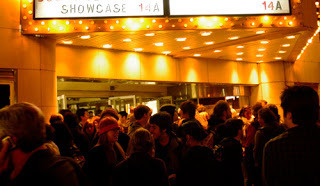 (photo snapped at the Ottawa International Animation Festival by Fran Kraus)
(photo snapped at the Ottawa International Animation Festival by Fran Kraus)When it comes to relationships in this biz I try to rely on my “spidey” sense, which is that little gut feeling that something is wrong. You can tell a lot about people based on how they follow through on a plan or how they handle themselves in a situation.
The first time I realized this I was working as a shift manager at a Pizza Hut when I was 17 years old. I had just come off three years working for McDonalds where I had worked up to the same position, so when I was hired at Pizza Hut they quickly bumped me up to the management position after a couple of weeks. They gave me a manager’s uniform, nametag, and made me the only manager on duty for most of my shifts. The woman who hired me, the head manager of the store, seemed very nice at first. Then, I noticed that the raise I was promised (that went along with my increased responsibilities) never materialized. Time dragged on but the head manager explained that the payroll situation was being resolved and promised there would be a retroactive check to account for the owed monies.
As much as I held out faith that I would be paid, the point of no return was three months later when my patience ran out. I was determined to have it out with her one day, but she was working up a step ladder, cleaning out an air filter with a rag. I asked her if we could discuss the money issue when she was done and she said, “No, we can talk about it now.” And, she proceeded to keep cleaning, never once looking back down at me while we talked about my missing raise. Plus, the discussion was in public. Any employee walking by could have heard us talking. The message in her attitude was so clear at this moment that it convinced me I was never getting the money that was owed me. I quit that day with no regrets.
Years later, when I began directing at Blue’s Clues, became president of ASIFA-East, and first started to build a reputation for myself in the larger industry beyond NYC, I attended the Ottawa International Animation Festival where a Hollywood bigwig took an interest in me and asked me to breakfast the next morning.
“I want to discuss your career and an opportunity for you,” he said.
The next morning we met at the agreed restaurant and as soon as we walked in, the Hollywood guy spotted a more important industry person than me and invited him to eat with us. Needless to say, the discussion about my career never took place and the supposed opportunity wasn’t brought up either. While that was disappointing, I was grateful that the Hollywood guy showed his colors so quickly. Here was someone I didn’t need to waste my time with.
I make a lot of mistakes, but I’m grateful for any moments of clarity where I had the sense to listen to my gut and avoid trouble or larger disappointments. I think everyone can better learn to listen to that inner voice that warns us to steer clear of some one or some thing. We're gonna get older either way, so we might as well also get wiser.
Published on February 27, 2012 05:47
February 18, 2012
The Kansas City Art Institute
 This past Thursday/Friday I was invited to speak at the Kansas City Art Institute by it's affable animation chair Doug Hudson. Doug, who has an MFA degree in Experimental Animation at Cal Arts where he was mentored by the late great Jules Engel, is also a multimedia artist and musician. He established the Student Academy Award-winning animation department for the Kansas City Art Institute in 2004. Past guest lecturers to the KCAI animation program have included John Canemaker, Suzan Pitt, Joanna Priestley, and Phil Mulloy.
This past Thursday/Friday I was invited to speak at the Kansas City Art Institute by it's affable animation chair Doug Hudson. Doug, who has an MFA degree in Experimental Animation at Cal Arts where he was mentored by the late great Jules Engel, is also a multimedia artist and musician. He established the Student Academy Award-winning animation department for the Kansas City Art Institute in 2004. Past guest lecturers to the KCAI animation program have included John Canemaker, Suzan Pitt, Joanna Priestley, and Phil Mulloy.Upon arrival to the school, Doug took me out to dinner with two of his esteemed faculty: John Baker (Digital Media and Animation teacher) and Christoph Steger (assistant professor and documentary animation filmmaker). Besides comparing notes as fellow animation instructors, the friendly bunch filled me with tales of local history, such as the plethora of underground railroad tunnels dug before the Civil War.
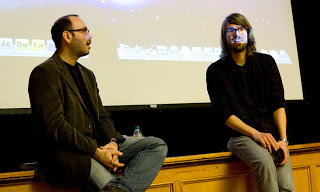 Pre-lecture I enjoyed a relaxing chat with Christoph Steger (pictured right), where he told me he recently worked on an hour-long animated documentary made in the UK. (photo by John Baker).
Pre-lecture I enjoyed a relaxing chat with Christoph Steger (pictured right), where he told me he recently worked on an hour-long animated documentary made in the UK. (photo by John Baker).My Thursday night lecture was a two-hour version of my SVA career class. My spiel is based on 14 key lessons I've learned from my time in the industry. Each lesson feels as personal to me as the films I've been making as of late. When I'm reliving each story in front of the students it feels like one part confession, one part motivational speech and one part the ravings of an animation Rabbi. What all that adds up to I have no idea, but I think everyone had a good time.
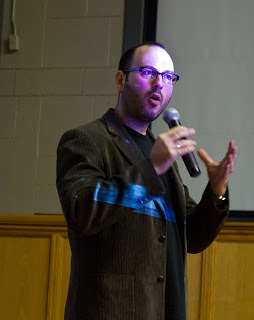 Captured in the moment by John Baker, surely reliving some industry trauma or hard-lesson learned.
Captured in the moment by John Baker, surely reliving some industry trauma or hard-lesson learned. The second day was a more informal chat with Doug's nine-member senior class. Knee-deep into their thesis films, some of them got up and presented animation tests, snippets of music or sound, and color studies from their works in process. The KCIA animation thesis track reminded me of RISD in the blend of experimental and narrative films on display. In addition, some students were working on projects that were part gallery installations.
After a lunch consisting of the greatest Rueben Sandwich in recorded history (great recommendation, Doug!!), I spent the rest of the afternoon having one-on-one chats with the students as they labored in a large studio space that would make cramped NYC animation students green with envy.
There are a lot of talented students in this program, and their passion to make it in this industry was undeniable. But, there was also a lot of humbleness in the air. Is that a Midwestern thing? Whatever the reason, it was refreshing to see.
The students had an acute awareness that upon graduation they needed to move to either NYC or LA. While it's true that animation artists can live anywhere today, it's important to first spend some amount of years working in an industry hub city, building up a reputation, and making contacts. After that, working from home (from anywhere) becomes a viable option. I can see some graduates of this program going out into the world and bringing those skills back to Kansas City and growing the local industry. Until then, as the students venture into this art/craft/business, I hope that they could somehow hold onto their wonderment of animation, their unassuming natures, and their obvious affection and support for each other.
Published on February 18, 2012 08:44
February 11, 2012
Animondays Interview: Stephen Hillenburg
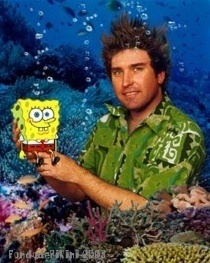 As an employee on a Nickelodeon production for over eight years, one of my perks was being able to attend company staff meetings where then-Nick president Herb Scannell would warmly explain the state of the company. If that wasn't enough, there was free Snapple. As part of his spiel, there would usually be video clips of upcoming Nick shows or movies. One day the clip introduced a little yellow sponge that would soon take the world by storm.
As an employee on a Nickelodeon production for over eight years, one of my perks was being able to attend company staff meetings where then-Nick president Herb Scannell would warmly explain the state of the company. If that wasn't enough, there was free Snapple. As part of his spiel, there would usually be video clips of upcoming Nick shows or movies. One day the clip introduced a little yellow sponge that would soon take the world by storm.If you've never taken the SpongeBob plunge, may I recommend seasons 1-3. They are simply magic.
On one hand SpongeBob was simply part of the continuum of Bugs Bunny, Woody Woodpecker, and other trickster characters with big personalities and signature loud laughs. On the other hand SpongeBob was innovative in that he ushered in the modern era of the innocent rube-like character, the naive man-child who looks at the world with unspoiled eyes. Of course this character type has existed before in literature, theatre, film, and TV, but SpongeBob gave us a new spin on the tradition and created a trend-setting phenomenon. Post SpongeBob, this character-type has echoed in animation, influencing such series as Cartoon Network's Chowder and Flap Jack.
While working at Nick in NYC, season one of SpongeBob became our water cooler conversation. So, one day I got the notion to call creator Stephen Hillenburg in Burbank to see if he'd agree to do an interview for the ASIFA-East newsletter. He agreed immediately and sent me back a great set of answers. Without further ado, here's a snapshot of the early days of SpongeBob from an interview dated April 2, 2001, and appearing for the first time in its entirety online. Enjoy!
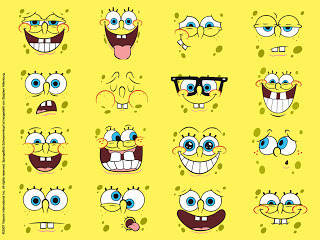
What was your background in animation before creating, developing and producing
Spongebob?
I attended CalArts and participated in the Experimental Animation graduate program under Jules Engel. During this time I produced two animated films, 'The Green Beret'( a short envolving a GirlScout with enormous hands) and 'Wormholes'( a short about a fly landing on a watch in 'relativityland') both of which toured the festival scene. I also created another film of straight ahead animation titled 'Animation Diary' which consisted of 365 drawings (one drawing drawn per day for the year 1991). After graduating I was hired to work on the Nickelodeon series 'Rocko's Modern Life'. I directed for three seasons and was promoted to Creative Director for the fourth season.
What pitch materials did you use to "sell" Spongebob to Nickelodeon?
I created a bible and a few paintings to explain the characters and their world. To supplement this I sculpted SpongeBob, Patrick and Squidward and put them in an aquarium where they were propelled by an air pump. I also recorded a temp theme song on a small tape recorder and mounted it inside a conch shell with a mercury switch, the song would play whenever the shell was lifted to the ear. I was also nude.
How much did the initial vision for Spongebob change or evolve from the original concept?
Did minor characters develop into more prominent roles?
Originally I wanted the show to focus on this innocent, optimistic, overly enthusiastic, sometimes odd and even magical character(SpongeBob) living this nautical fantasy world. I think we've pretty much stayed on course. The key has been finding stories where either SpongeBob prevails innocently or where his innocence causes a conflict for himself. I wanted the overall sensiblity of the world to be wild and surreal yet have logic. Most of the original cast remains with no real change in their importance.
How did you come to meet the people who work on the show like Derek Drymon, Aaron Springer, Mr. Lawrence, Sherm Cohen, and Paul Tibbitt?
I'm lucky I guess! There is a direct relationship between the success of this show and my immensely creative staff. These guys and all the other crew members are hard to find and hard to replace.A few people (Derek Drymon for example) worked on 'Rocko'. Most of the people I find through word of mouth.You have somebody on the staff you like and trust, they recommend someone they think would fit in nicely on the show. Often you're searching for someone that has the right sensibility, the appropriate sense of humor ( someone who 'gets it' ).
What, if any, roles have you taken on in producing Spongebob that you don't enjoy?
Managing people is an essential part of producing a show but managing people can be tiring. I like going to work and being creative. When the other stuff gets in the way it's a drag.
Many of the new wave of television cartoons including Courage the Cowardly Dog, Power Puff Girls and your show feature the storyboard credit prominently before each cartoon, alongside the director's name. What is the role of storyboard artists on Spongebob? In addition to their work on boards, do they make major writing and directorial contributions to the show?
On SpongeBob a writing team writes the premise. Then a Director and Storyboard artist 'team' write the episode in 'comic' or storyboard form. We do not storyboard from script.
The story ideas for spongebob are very simple, well told, entertaining and full of great little touches like the poor fish who keeps getting hit by the anchor toss in the muscle beach competition in the episode where Spongebob gets fake muscle arms. At what point do the smaller details that end up contributing so much to the overall effect get into your show? Where do these ideas come from? Do you ever wonder if one more gag or one less gag could make or break a sequence?
Our overall philosophy has been keep it simple. Try to find humor in a simple situation ( that hopefully reaches absurd proportions). Put the characters together and watch what happens...you know like red ants and black ants. We are only doing eleven minute stories so there are not alot of subplots. Sometimes we will build an entire act around one silly concept. SpongeBob and Patrick both have candy bars. Patrick is so stupid that he forgets that he has just eaten his and believes the one SpongeBob holds was his. SpongeBob is now a thief. The humor should always come from character. The ideas come from everywhere and anyone. Things like childhood memories. When developing stories we often play non-linear thinking exercises ( like pulling words out of a hat and writing a situation inspired by the word ). Ultimately the ideas that stick are the ones that consistently make everyone laugh. As far as the number of gags goes, I definitely think the pacing of a section can be bogged down by too many jokes.
Some entire episodes of Spongebob can be understood with the sound turned off....for instance, the episode in which Spongebob delights in the limitless joys of a simple piece of paper. How do you balance the visual to verbal content of the show from each episode's inception?
What probably helps most here is reviewing all drafts of the story ( after the outline stage) either as a storyboard or an animatic,
doing visual and verbal rewrites simultaneuosly.
Several episodes of Spongebob feature terrific song segments that are woven effectively into the plot lines, such as the "friendship song" sung by Plankton and SB, the "ripped my pants" song and Sandy's "wish I was back in Texas". Did the song ideas evolve out of the plot lines or did the plot lines evolve out of the song ideas?
All the above songs were written after the plot was determined.
There is an LA based group of artists that draw heavily upon cartoon (and animation) imagery in their work (Mike Kelley, Paul McCarthy, etc.) Have these artists or any other contemporary art world influences inspired Spongebob in any way?
I was at this museum once that had a room full of cartoony Mike Kelley drawings that were all really bizarre. A group of elementary kids led by a museum docent entered the room and got really excited about the drawings. A few were examining this depiction of I think Abe Lincoln with brain waves and others were pointing at this one drawing of a goose biting a little boy on the penis. The docent was clearly uncomfortable and quickly ushered them out of the room (against their will ) to the next exhibit. I've always wanted SpongeBob to be that compelling....did I answer the question?
Did you experience any resistance from "the network" in incorporating live-action elements into SB? (Like in "The Suds" episode when the hand reaches in and grabs the characters and washes them out)
No. They were a little worried about 'Patchy the Pirate' though.
How do you maintain the high quality look of your show when dealing with an overseas studio handling the animation?
Our overseas studio is Rough Draft. They are really the best studio in Korea for cartoony animation. Sure there's communication barriers but those guys work really hard and have some talented cartoonists on board. Also they are quite familiar with other Nickelodeon shows such as 'Ren and Stimpy' and 'Rocko's Modern Life' where layouts were done from detailed storyboards.
Did you cast the show yourself? Do you ever do any VOs on the show?
Donna Grillo and I cast the show. I would explain to Donna the specific voices I had in mind for each character and she would recommend a list of candidates. I did the voice of 'Potty' the parrot in the 'Patchy the Pirate' live action segments. Anybody can do a parrot.
What's your personal favorite SB episode to date and why?
Being so close to the project it's impossible for me to have a favorite. I think the shows get better and better. The characters become more developed, the animation more consistent.
Were Spongebob's nocturnal dream traveling adventures at least partially inspired by the Sour Puss and Gandy cartoons made at Terrytoons in the early 1940s?
I'm not sure.That was an idea Doug Lawrence hatched.
The character of Bubble Bass and Spongebob seem to have a Jerry and Newman relationship, a-la Seinfeld. What films, television shows, comics...etc, do you draw creative inspiration from?
For this particular series anything that deals with 'Candide'-like innocence. Chaplin, Buster Keaton, Laurel and Hardy, Pee-Wee,
The Muppets. Movies like 'My Life as a Dog' or 'A Christmas Story'. Also Popeye, Beany and Cecil, Krazy Kat, Dr.Suess, Yellow Submarine, Calvin and Hobbes. I should mention that a great deal of the inspiration for the series came from my interest in marine biology and surf culture.
Spongebob draws a large adult following. Are you surprised that adults have taken to your show?
Yes and no. It is Saturday am TV, but since we write things that make us laugh one could assume other adults would also find the show amusing. We definitely don't pander to kids...but we also try not to write over their heads. I was more surprised to hear about college students playing drinking games while watching 'Blue's Clues'.
What animated shows, if any, do you measure your work on Spongebob against or consider your creative competition.
'Ren and Stimpy' and 'The Simpsons' raised the bar for all TV animation. Those shows really inspired us to try to do something memorable or maybe even groundbreaking. At they same time we are fighting hard to not copy them. Always asking 'How can we not be like those shows?'
What independent animators/animated films do you admire?
Jules Engel. He's singlehandedly taught and inspired countless independent animators. His age is a mystery.
Paul Driessen. When I was thirteen I went to a Tournee of Animation and saw 'The Killing of an Egg'. That film made a lasting impression on me.
Richard Condie. 'The Big Snit' has got to be one of the greatest indies ever.
If you had three wishes, what would they be?
1.Pleasure for all things living and non-living.
2.To never have to 'high five' an industry executive.
3.That they resume production of 'Tombow'2B pencil.
Published on February 11, 2012 04:56
February 5, 2012
Animondays Interview: Nina Paley
 Nina Paley beaming with pride in front of NYC's IFC Theatre with her film on the Marquee. Her feature ran at the theatre from Dec 25-31, 2009.
Nina Paley beaming with pride in front of NYC's IFC Theatre with her film on the Marquee. Her feature ran at the theatre from Dec 25-31, 2009.When I wrote my recent book, Directing Animation, it was an absolute must to talk to Nina Paley for two reasons. One, she made a wonderful and practically self-funded and self-produced feature length animated film: Sita Sings the Blues. And, two, she inadvertently pioneered a new means of distribution in the process. When I asked Nina if she'd agree to an interview for my book, her one condition was that we chat on the phone instead of emailing a set of questions and answers back and forth. This worked out really well and allowed me to better explore certain areas with follow up questions. Luckily I was able to type as fast as we talked. Maybe if my animation career stalls I can fall back as a Steno.
Without further ado, appearing for the first time in its entirety, here's my interview with Nina Paley from September 16, 2009:
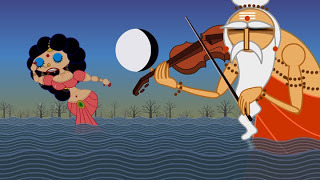 An emotional moment from "Sita," in a film chock-full of them.
An emotional moment from "Sita," in a film chock-full of them.1-What skill sets go into directing animation for a feature film?
I directed my computer, not other animators... so from my experience, the important part was knowing how to use and work with my computer. Sita happened magically. Its based on an old and long story. It appeared with the story structure in place, the beginning, middle and end were already there.
I wasn't sitting around wanting to do a feature. I had no intention of doing a feature film. But, I felt compelled to make it real. There's a reason I'm not making another feature. I will only do it if another idea comes along that makes me have to do it.
I get lots of ideas, so I can't possibly make all of them into pieces of art... but, some of them stick and won't go away...my next thing is a book, but not because I want to write a book.
I don't know what's a good or bad reason to make art.. there's all kinds of motiviations.... being an artist is hard, there's not really money in it... so having a motivation other then money seems good. There should be some reason to do it other than money.
2-Can you list some common mistakes and challenges that are faced by the first time feature animation director?
I only made one feature... but, I will say that one man's mistake is another man's virtue. People give you a lot of warnings about mistakes you can make... I think that sometimes the biggest mistake you can make is listening to those warnings, especially listening on copyright issues. The advice there is wrong, technically and morally wrong. Listen to your quiet inner voice instead. Sita would not have existed if I had listened to the advice I got.
There are lawyers that are writing this info on copyright, warning us: just don't use old stuff, only use stuff that's clear, and raise the money first. But, you don't have to raise the money first nowadays... art doesn't obey any laws. Tell that to the muse... or don't tell it to the muse.
3-How, if at all, is directing a feature different then directing shorts?
There were differences... I knew the story would have to be structurally different... there had to be something that held everything together. It doesn't always come together... I see a lot of features where something is just not there. Possibly I was lucky becasuse (as a solo effort) I wasn't destroyed by committee.
4-What part of directing a feature gave you the most satisfaction?
A lot of things. One thing was the commitment of it. Knowing what it was.. having a large and clear goal... Every day I felt I could work on it. There was a daily communion with art. Once I made the commitment, I didn't worry about whether it was crazy, I just did what I needed to do each day.
5-Where did you learn your sense of timing, acting, staging, and storytelling that is so essential in directing feature animation?
I was not formally trained. Probably I learned like how you learn how to talk: by listening. It's like a language. I picked it up by observing and being exposed to media.
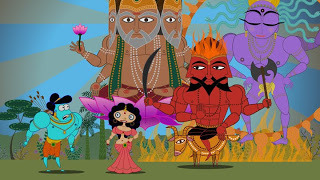 Another eye-popping moment from "Sita."
Another eye-popping moment from "Sita." 6-How long did your feature production take, how did you pay for it, and how would you describe your distribution model?
3 years of work spread over 5 years of time. I started in 2005, finished in 2008. The very beginnings of it were in 2002, as a short. I took a few breaks to do freelance work. One really great thing, once I was committed to the project and willing to be poor, I called my parents to ask if I ran out of money, if I could go back and live with them...and they said, "yes." So I had that to fall back on. I very consciously avoided worrying about the money. I had a new age approach to it that it will work out: "You'll be OK no matter what. You can sleep on peoples' sofas...people won't let you die."
I read the comments on cartoonbrew and talk to artists, and there is a real fear of starving to death, but the fact is your friends and family won't let you starve to death... even me (and I have a stressful relationship with my family). And, I will take care of others the same way.
3 ways to reckon the budget is: it was $80,000 for production costs, without food and rent. This included sound design, commisioning music, actors, dubs and prints.
If you include food and rent, the total cost would be $200,000. My primary expense was me. The costs of licensing the music was $70,000. That broke down to $50,000 in license fees and 20,000 for transactions costs.
I didn't think of finishing the film as a tool to raise this money. And when I was finished, I was prohibited by law to give it away for free. The law distinguishes between commercial and non commercial infringement. Either way I could have gone to jail. I cleared these things because I wanted to show it for free... There's more money in showing it for free than with a proprietary conventional distrubition model. You need a ton of money to promote a feature, and access to theatres. If you are an independent, you don't control the media stream. A film that has a small promotion budget is a killer, so many small films have been released but there haven't been enough publicity around them. Their costs are never recouped. Most feature filmmakers I've talked to have made zero dollars on the back end. Their investors paid them a salary/advance to make the film, 10 or 20 thousand dollars.
If you're lucky, people will see your film. I can be broke without the help of a distributor. More can see it if I release it freely.
Ten years ago it would have been very different. The film could not exist. Ten years ago it would have gone through a conventional distribution. Now the internet offers all these fab ways to share information...
Today the only limited resource is peoples' minds. There's not enough hours in the day to pay attention to all the good stuff. There's so much stuff I want to read and look at each day. There's competition over eyeballs... over peoples' attention.
The good thing about competition is if things are good, they are likelier to... you know, quality is a kind of the survival of the fittest right now. The model we are emerging from is the winner takes all, and a few things take over everything––becoming mega popular. The execs are all looking for that... something that can be really good but only attract a small audience won't interest that old exec. In the new model you can get some kind of audience for almost anything, but it takes time and there's a lot of stuff competing... The stuff that will get eyeballs is stuff people recommend to other people. Things don't have to be blockbusters.
There were a lot of steaming turds that did fine in the three-network TV days because we all just watched what was on TV that night, but, nowadays if you make a turd, it competes with a lot of other stuff that people might like more because it's better. That's why old media has its nickers in a twist.
Published on February 05, 2012 12:14
January 29, 2012
The Loneliness of the Long Distance Pitcher

Last week I crammed in a three-day whirlwind trip to LA to pitch a new project with my co-creators, the Levinson bros. Our reception ran the full rollercoaster from red hot "I wouldn't change a thing" and "this is just what were looking for," to "Love it, but we don't need it" to "I like the tone, and one of the characters, but..." to a scathing rejection of every single element. Ouch!
Three things I was reminded of this week:
One is that development execs are people like you and me (duh), albeit probably better paid. As with any group of "real" people, they can't be reduced to a single stereotype. The execs we met with were motherly, aloof, sympathetic, bored, excitable, opinionated, tight-lipped, lackluster, and inspirational.
Two, because of the above, showing a project is akin to a rorschach test, probably saying as much about the exec's pysche as anything else... The variety of reactions on one project could be comical at times. One exec said "your character is too mild and meek," the same day another declared "I'm not seeing the mild and meek side of the character." Moments like that can actually help a creator relax. Because, what does it all mean anyway?
Three, during the pitch process creators collect A LOT of data on what the networks are currently looking for. And this brings up the great dilemma: what the hell to do with that info? If you want, you can let this outside influence in, and return with a paint-by-numbers show tailor-made to these instructions. In the past, that's just what I'd do. It was like a game to me. But how often did that new idea really connect with "me"? The truth is that the best creation comes from within. When Pen Ward built the odd, random, and fun world of Adventure Time he did so from an honest place that was so real to him... It WAS him. But now some execs use his show as what they expect from you too.
One exec summed up what they are looking for as being louder, wilder, and even more random than Adventure Time. But I can't help believing that the next big thing won't be defined by Adventure Time, just as Adventure Time wasn't defined by SpongeBob. History taught us: Looney Tunes beat Disney by not being Disney.
So what to do with this feedback? Maybe it's my age (half my stubble is gray now), but I'd rather be ME even if it paints me eternally uncool and uncommercial because I've learned-- if it ain't personal, it's nothing.
Speaking of the personal, this trip gave me a chance to meet up with two sets of cousins from my fathers side of the family, whom even my father has never met. So it was pitching by day and family reunions at night. Ironic, in a way, because that's like following one type of stress with another. As accustomed as I am to pitching now, it still requires a great deal of energy and nerve. After a meeting, the toll of the experience hits me. There's always a deep breath as I walk out the door.
But, instead of creating added stress, these pitches made meeting "new" family seem like a break or reward at the end of the day. Happily, my new extended family were all wonderful people. It was a joy to make their acquaintance and help build a bridge across time.
We are all the descendants of my Great Grandfather Isaac Levy.
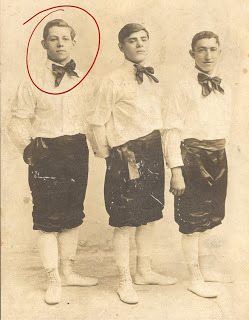
Isaac was head of an acrobatic trio that preformed in vaudeville with my Great Grandfather being the strong man (bottom guy). They once shared a stage with Eddie Cantor. One of Isaac's daughters went into showbiz too, shaping her three children into a successful family of Flamenco dancers and singers that starred in an Oscar-nominated short called "Bombalera" in 1945.
It seemed natural to be meeting some of Isaac's offspring in the industy town of Burbank all these years later. Whatever the fate of the pitches, connecting with my relatives gave me my "Hollywood" ending.

Published on January 29, 2012 07:37
David B. Levy's Blog
- David B. Levy's profile
- 1 follower
David B. Levy isn't a Goodreads Author
(yet),
but they
do have a blog,
so here are some recent posts imported from
their feed.




